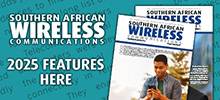03 April 2025
Transforming Fixed Wireless Access

Wim Van Thillo, CEO, Pharrowtech
Africa is undergoing a digital transformation, driven by a young, fast-growing population, thriving cities, and an increasing demand for connectivity. With its population expected to nearly double by 2050, Africa presents immense potential for economic growth and technological advancement. However, persistent challenges such as economic fragility, rising spending pressures on infrastructure, health, and education, as well as a deep digital divide, continue to limit progress. Millions of Africans remain without access to the internet, restricting opportunities in education, e-commerce, and remote work.
The connectivity challenge
While fiber networks have played a crucial role in broadband expansion globally, they face significant obstacles in Africa. The absence of legacy internet infrastructure means that upgrades are not an option, requiring costly new investments. Additionally, fiber installation is expensive and generally limited to densely populated urban areas where capital expenditure can be justified. Moreover, environmental factors such as challenging topography and the disruptive nature of underground cabling further complicate fiber deployment.
5G deployment in Africa lags behind the rest of the world due to spectrum constraints, infrastructure limitations, and affordability concerns. At the same time, satellite internet has also been proposed as a potential solution, but its high latency and low throughput make it impractical for long-term, large-scale connectivity.
Could FWA help bridge the digital divide?
Fixed Wireless Access (FWA) has emerged as a powerful alternative to traditional broadband solutions. Not only can FWA provide reliable, high-speed connectivity, but it can also be deployed rapidly and at a significantly lower cost than fiber, as it does not require extensive physical infrastructure.
Furthermore, FWA can utilize unlicensed frequency bands, reducing barriers to entry for ISPs and fostering competition. This competition helps drive down costs, making broadband more affordable for consumers — a critical factor in developing economies. Recognizing the need for alternative broadband solutions, several national regulatory authorities have made a groundbreaking decision by opening the 60GHz band for outdoor use. This move is a game-changer for FWA providers, offering several advantages:
- High-speed connectivity: The 60GHz spectrum provides abundant bandwidth and ultra-fast speeds, delivering gigabit-level performance comparable to fiber.
- Lower deployment costs: FWA networks utilizing the 60GHz band are up to 45% cheaper to deploy than fiber rollouts in urban areas, making broadband access more widespread and affordable.
- Rapid scalability: Unlike fiber, which requires extensive trenching and investment, FWA can be deployed quickly, allowing service providers to scale their networks efficiently.
- Reduced network congestion: Many wireless ISPs (WISPs) currently rely on congested 5GHz bands. The 5GHz spectrum, while effective for some applications, suffers from significant interference due to widespread usage by Wi-Fi networks, home routers, and existing FWA deployments. This congestion leads to increased latency, reduced data rates, and inconsistent performance, particularly in high-density urban areas. The 60GHz spectrum offers a clean, interference-free alternative for robust, high-speed connectivity, alleviating many of the challenges faced by ISPs operating in congested environments.
While FWA cannot entirely replace fiber backhaul and last-mile connectivity in high-density areas, it serves as a highly complementary solution. By rapidly extending high-speed broadband to underserved communities, FWA can unlock new opportunities in education, commerce, and remote work, helping to drive social and economic progress.
In densely populated cities, where multi-dwelling units and informal settlements pose unique connectivity challenges, 60GHz-based FWA provides an efficient and cost-effective way to deploy high-speed internet without the need for extensive cabling or disruptive trenching.

How WISPs can capitalize on the FWA opportunity
The opportunity for WISPs, particularly in urban areas, is substantial. As FWA solutions improve and key mmWave spectrum bands like 60GHz become widely available, it enables WISPs to rapidly address the needs of unserved and underserved communities, catalyzing economic development across African cities.
The opening of the 60GHz spectrum is just the beginning. Ongoing spectrum allocation efforts, combined with technological innovations such as advanced beam-steering techniques, will further amplify FWA’s disruptive potential.
CMOS vs SiGe: the advantage of cost and scalability
In the development of FWA solutions, the choice of semiconductor technology plays a crucial role in determining cost, efficiency, and scalability. Two key contenders in the mmWave domain are Complementary Metal-Oxide-Semiconductor (CMOS) and Silicon-Germanium (SiGe).
CMOS technology is highly advantageous due to its lower cost, lower power consumption, and scalability. This makes CMOS a more attractive option for mass production, helping to reduce the overall cost of 60GHz FWA equipment.
SiGe offers some performance advantages. However, the higher production costs and limited production scalability of SiGe make it less suitable for large-scale broadband deployments.
As 60GHz FWA adoption grows, CMOS-based solutions are likely to dominate due to their affordability, scalability and ease of integration into consumer devices, further driving widespread connectivity across Africa.
Economic and social implications
The widespread deployment of FWA technology extends far beyond mere connectivity — it acts as a catalyst for economic growth, education, and social inclusion. By expanding broadband access, businesses can reach new digital markets, students can access vital online educational resources, and remote work opportunities can become more accessible.
Additionally, the lower barrier to entry in the 60GHz band encourages increased competition among WISPs, which in turn drives down costs for consumers and stimulates innovation in service delivery. This is particularly significant in Africa, where affordability remains a major challenge in achieving widespread broadband adoption.
As more countries across the continent adopt forward-thinking spectrum policies, FWA is set to become a dominant force in Africa’s broadband landscape. The technology’s ability to provide high-speed, scalable, and cost-effective connectivity positions it as a cornerstone of Africa’s digital transformation.
Conclusion
Africa stands on the brink of a connectivity revolution. With the expansion of the 60GHz spectrum, WISPs and telecom providers now have a powerful tool to drive digital inclusion. By leveraging this technology, Africa can accelerate its path toward universal broadband access, unlocking economic opportunities and enhancing the quality of life for millions.
The future of connectivity is wireless, and the 60GHz spectrum is paving the way for an inclusive, high-speed digital Africa.





.gif?lu=925)

